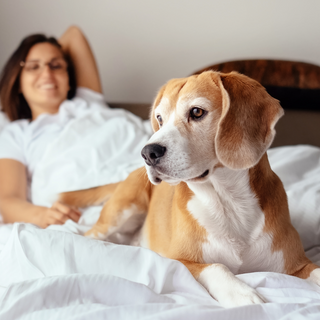Sofa injuries - a case study
Inside issue 62 of Edition Dog Magazine we catch up with the Canine Massage Guild to discover the risks jumping on the sofa poses to your dog, and how to minimise this risk. The feature below is a case study, written by Suzanne Alexander from the Canine Massage Guild, which highlights the injuries caused by this activity and the way in with canine massage can help alleviate the injuries.
As dog owners, we often see advice about repetitive activities. However, over time, these actions can lead to soft-tissue issues or injury, expedite the onset of orthopaedic conditions or exasperate existing ones. Jumping on and off the sofa is certainly one of them. This activity often goes unnoticed until the dog gets a bit older, stiffer and not quite as athletic as they once were. Indeed, this might even be the initial trigger to research Clinical Canine Massage.
However, this activity also runs the risk of sudden injury. When we think of any sporting activity, be it human or canine, it's safe to say we are all educated on the importance of warming up beforehand. Warming up helps to reduce the chances of injury, particularly muscle strains. When a dog suddenly wakes from a deep sleep and launches onto the sofa, perhaps in hot pursuit of a piece of dropped cheese, you can see how an injury might happen!!
Nothing obvious
This is exactly what happened to one of my dogs, Ceilidh, a few years before I trained as a therapist: a small yelp was initially the only sign. But the next day, she lay on the floor, very quiet and clearly in pain. A visit to the Vet revealed nothing obvious, with soft-tissue damage being suspected. A course of Metacam with a 'wait and see approach was taken' and within a few days, she appeared back to normal. It was during the Summer, and a very hot one at that, which meant exercise was limited to shorter walks or runs when temperatures allowed. As the year went on, running distances increased, and that's when we noticed a subtle change in her gait.

Changes in gait
We noticed that her hind footfall was not tracking in a parallel plane with her front footfall. And yet, this wasn't the same as you would see with 'crabbing' or 'sidewinding' as her spinal column appeared to be pointing straight forward and not in an oblique or 'diagonal' line to the direction of travel. The unique vantage point running sled dogs gives you meant this was easier to spot.
No cause was found, although I recall thinking that complementary therapy, for example, Physiotherapy or Clinical Massage, might have helped. However, back then, I could only find therapists who worked with Horses! She continued to run happily in her harness with no issues until older age eventually caught up with her, and then more sedate walks were enjoyed. Around this time, I was accepted into the Clinical Canine Massage Practitioner Programme with the Canine Massage Therapy Centre and began a 2-year journey. The first year involved completing nine incredibly in-depth modules where we essentially learned about all of the canine systems, inside and out.
Identifying a strain
In the second year, we progressed to the practical sessions, and one of the most important things, which took a long time to hone, was learning the art of palpation or ‘seeing with your fingers’. This essential skill allows the therapist to feel what most scans cannot see: the tone, temperature, texture and tenderness of the tissues. Keen as mustard, I was fortunate that I had several of my own dogs who helped me so much on my learning journey. It was only then that I realised the full extent of the injury Ceilidh sustained that day she jumped off the sofa.
What I identified was a large area of scar tissue in her left Longissimus Dorsi and Iliocostalis muscles, with a small amount also present in her left Latissimus Dorsi muscle. When muscle fibres are torn to some degree, we refer to this as a strain. The body quickly lays down scar tissue to repair the muscle and knit the fibres together. Whilst this repair is effective, scar tissue itself is up to 50% less flexible than muscle fibres; it is more receptive to pain and vulnerable to restraint. As Ceilidh moved, the affected muscles on the left side of her spine (all of which originate from (attach to) various points of the Pelvis and Vertebrae) could not lengthen as efficiently or effectively as those on the right. Over time, this had led to a slight Pelvic rotation, which resulted in the gait changes we had seen. Sadly, we lost her not long after that, but she led a long and happy life, and that is always something to cherish.

Complementing therapies
Interestingly, after I completed my training and started working as a therapist, I came across a similar albeit more severe injury in a Greyhound who was staying at a foster home prior to being rehomed. He had two sessions of Clinical Massage with me to help restructure the scar tissue. I then recommended a Mctimoney Chiropractic adjustment to address the Pelvic rotation before the 3rd and final initial session with myself. This worked well, and a good improvement was seen. Whilst we can never remove scar tissue, we can help restructure the damaged fibres: ongoing maintenance sessions are likely to be indicated. This was also a perfect example of how different complementary therapies can often work well together for the best outcome.
Dogs are masters at hiding discomfort with subtle changes or 'just a yelp', often being the only sign. But there aren’t always signs, and this is why a Muscular Health check can be so invaluable. Changes in the tone, texture, temperature and tenderness of the soft tissues can be a sign of an injury, but they can also be in response to an underlying condition. A Muscular Health Check is something I regularly do with my dogs. It means I can address any soft-tissue issues promptly or have a Vet investigate further if necessary. You will often see Canine Massage Guild therapists at shows or events such as Edition Dog Live offering free Muscular Health checks: don’t hesitate to have your dog checked. Thankfully, if Clinical Canine Massage is indicated, there is bound to be a therapist near you!
About the author
Suzanne Alexander is a member of the Canine Massage Guild. She is currently focused on using Clinical Canine Massage to help maintain the overall health of her numerous sled dogs & also her Collie.
https://www.facebook.com/Cryanreuch
About the Canine Massage Guild
After ten years, the Canine Massage Guild continues to lead the way with a network of highly skilled Clinical Canine Massage Therapists nationwide. We specialise in soft tissue rehabilitation and provide chronic pain management for orthopaedic conditions.
Find your local Canine Massage Guild therapist:
- Choosing a selection results in a full page refresh.


